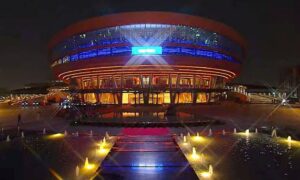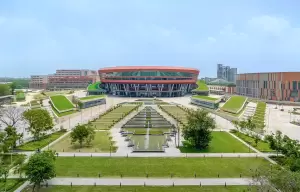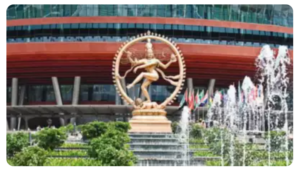Bharat Mandapam- A Cultural Corridor
Why in the news?
- Bharat Mandapam, an IECC complex is all set to showcase a cultural corridor showcasing heritage from G-20 nations. It is the main venue for representing India’s democratic traditions and will greet the heads of state and other delegates during the G20 summit. An exhibition themed on India as the ‘Mother of Democracy’ is being hosted at the Bharat Mandapam.
- Upon arrival of the delegates, an Artificial Intelligence avatar will greet them and will narrate the long history and tradition of the Indian Democratic system, and a huge video screen at the back of the reception will showcase the visuals of India’s rich cultural traditions.
 |
About Bharat Mandapam.
- The international exhibition-cum-convention Centre (IECC) complex named Bharat Mandapamis is located in the heart of the national capital and embraces the fluidity of river Yamuna.
- The IECC complex is India’s largest MICE (meetings, incentives, conferences, and exhibitions) destination and features state-of-the-art facilities, including a convention center, exhibition halls, and an amphitheater.
- The term ‘Bharat Mandapam’ is derived from Lord Basaveshwara’s concept of ‘Anubhav Mantapa,’ which was a significant institution in the 12th century.
- Bharat Mandapam is a symbol of India’s idea of ‘the whole earth is one family’.
- The awe-inspiring world’s tallest Nataraja statue, standing at an impressive 28 feet, symbolizing the grandeur of this monumental event on Indian soil.
- The Bharat Mandapam also abuts Lutyens’ Delhi and also has a ‘Window to Delhi’ at the highest level which looks out to the Kartavya Path, the India Gate, and the canopies of the Rashtrapati Bhawan.
- It is an iconic landmark and a modern building connected to the Indian roots- PM Narendra Modi.
| What is ‘Anubhav Mantapa’?
Anubhav Mantapa is considered one of the earliest parliaments in human history, where poets and socio-spiritual reformers known as Sharanas discussed and deliberated on various reforms. |
| Architectural design of Bharat Mandapam.
· It is in elliptical design devoid of any sharp edges. · The construction of the podium reflects the shape of water that is rising up. · Integration of traditional art elements on walls and facades with artwork themed around the peacock, the national bird. Designed by Aedas, the architect of Marina Bay Sands, and Indian firm Arcop, involved in IGI Airport Terminal 3. |
| Remarkable features
· Larger seating capacity than the iconic Sydney Opera House, accommodating around 5,900 people. · Spans over an area of 53,399 sq m with a cost of around Rs 2,700 crore. · Accommodates 7,000 people in its multi-purpose and plenary halls combined. |
| About Nataraja Statue
The 28-foot-tall Nataraja statue, brought from Tamil Nadu is installed at the entrance of the Bharat Mandapam for the G20 summit in the city. These Sthapatyas have been carving with the traditional lost wax techniques since the time of the Chola empire. This is also known as the Asthdhatu Nataraja statue as it is made up of eight metals which also include mercury, iron, and tin which makes them very strong.
Significance of Nataraja Statue · The statue shows Lord Shiva as the lord of the dance. It combines Shiva’s role as a creator, preserver, and destroyer of the universe and conveys the never-ending cycle of time in one image. · It relates to the Hindu principles of Karma (action) and Janma (reincarnations). It has four hands, artistically constructed with a specific purpose. · The arch around the figure represents his cosmic theatre and the drum in his raised right hand symbolizes creation as it causes vibration. The lower right hand shows a sign of protection and assurance of well-being. · The raised left fire symbolizes dissolution (not destruction). · The lower left hand is stretched across the chest towards the right side (technically called Kari hasta, like the trunk of an elephant), with the fingers pointing to the raised left foot on the right side. · This raised foot is the ultimate home of tired souls released from earthly bondage. In other words, it is the final refuge (Moksha). · The right foot is seen crushing a demonic dwarf, who symbolizes human depravity caused by ignorance leading to ego. |





